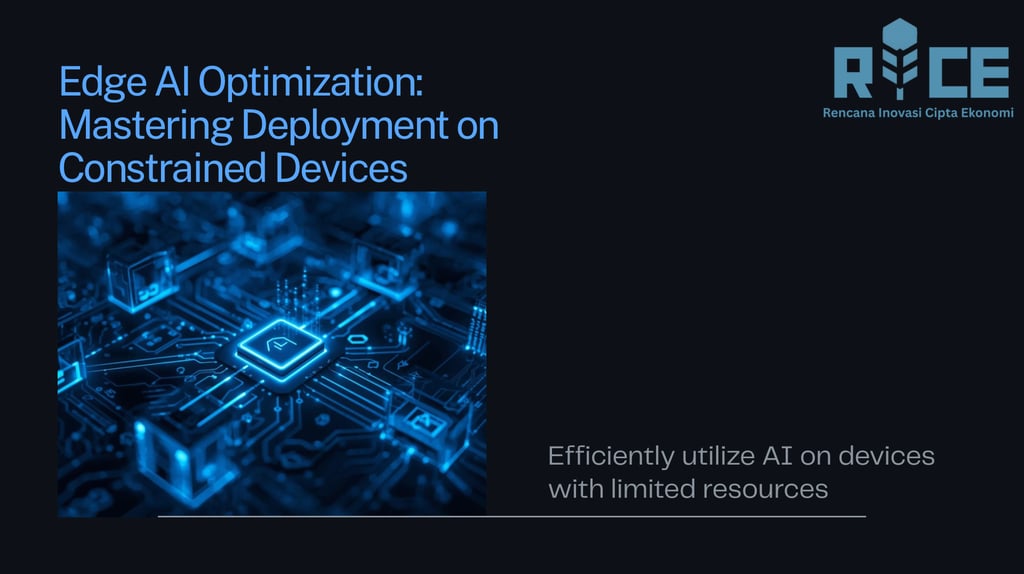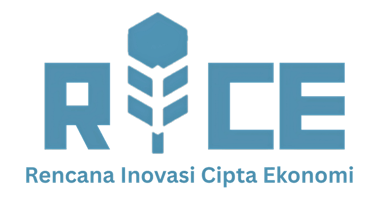Edge AI Optimization: Mastering High-Performance Model Deployment on Constrained Devices
Deploy high-performance models on constrained devices, reducing latency, enhancing privacy, and maximizing efficiency.
AI INSIGHT
Rice AI (Ratna)
10/23/20258 min read


The future of artificial intelligence is undeniably moving to the edge. As industries demand increasingly real-time insights and autonomous decision-making, the ability to process AI models directly on local devices, rather than relying solely on centralized cloud infrastructure, becomes paramount. This shift to Edge AI promises transformative benefits, including reduced latency, enhanced data privacy, and improved operational efficiency across countless applications from smart manufacturing to autonomous vehicles. However, deploying sophisticated AI models onto constrained devices like IoT sensors, embedded systems, and mobile chipsets presents significant challenges, primarily concerning limited compute power, memory, and energy resources.
This ultimate guide will equip you with a comprehensive understanding of the strategies and techniques essential for AI optimization, enabling the successful deployment of high-performance models on even the most resource-scarce edge environments. We will explore the critical methods that bridge the gap between powerful neural networks and frugal hardware, ensuring your edge computing initiatives achieve their full potential. At Rice AI, we specialize in navigating these complexities, empowering businesses to unlock the true power of intelligent edge deployments.
The Imperative of Edge AI: Why Optimization Matters
Why are organizations worldwide prioritizing the migration of machine learning inference to the edge? The motivations are compelling and multifaceted. Firstly, lower latency is a primary driver. Processing data locally eliminates the round-trip delay to a cloud server, critical for applications requiring instantaneous responses, such as real-time anomaly detection or robotic control. Secondly, enhanced privacy and security are crucial, particularly in sensitive sectors like healthcare or defense. Keeping data on-device minimizes exposure and adheres to stringent regulatory requirements.
Thirdly, reduced bandwidth consumption significantly lowers operational costs and improves reliability in environments with intermittent connectivity. Fourthly, increased reliability means that even if network access is lost, the edge device can continue to function autonomously. Finally, energy efficiency is a cornerstone of sustainable and scalable IoT deployments. Unoptimized models can quickly drain device batteries, undermining their utility. The array of constrained devices – from microcontrollers powering smart wearables to industrial sensors in remote locations – each brings unique limitations. These devices typically feature limited CPU/GPU cycles, smaller RAM footprints, and strict power budgets. Without meticulous AI optimization, these constraints render many advanced deep learning models impractical, highlighting why understanding these techniques is not just an advantage, but a necessity for effective model deployment.
Core Optimization Strategies for Edge AI
Achieving high-performance models on constrained devices necessitates a multi-pronged approach to AI optimization. This involves transforming models to be smaller, faster, and more energy-efficient without sacrificing critical accuracy.
Model Compression Techniques
Model compression is foundational for edge AI, making large neural networks viable for tiny resources.
# Quantization
Quantization is a pivotal technique that reduces the numerical precision of a model's weights and activations. Most deep learning models are trained using 32-bit floating-point numbers (FP32). By converting these to lower precision formats, such as 16-bit floating-point (FP16), 8-bit integers (INT8), or even binary (INT1) or ternary representations, significant memory savings and computational speedups can be achieved. This reduction directly translates to lower memory footprint and faster inference times, as operations on lower precision numbers are computationally less intensive. While quantization can introduce minor accuracy degradation, techniques like Quantization-Aware Training (QAT) help mitigate this by simulating quantization during the training phase.
# Pruning
Pruning involves removing redundant or less important weights and neurons from a neural network. Just as a gardener prunes a plant for healthier growth, we prune models to remove computational overhead. Unstructured pruning removes individual weights based on magnitude, often leading to sparse models that require specialized hardware or software to fully benefit. Structured pruning, conversely, removes entire channels, filters, or layers, resulting in smaller, denser models that are more compatible with standard hardware accelerators. This technique can drastically reduce the number of parameters and floating-point operations (FLOPs), leading to faster inference and smaller model sizes.
# Knowledge Distillation
Knowledge Distillation is a technique where a smaller, simpler "student" model is trained to mimic the behavior of a larger, more complex "teacher" model. The teacher model, often a highly accurate but resource-intensive network, provides "soft targets" (e.g., probability distributions over classes) in addition to the true labels during the student's training. This process allows the student model to learn the nuances of the teacher's decision-making process, often achieving a surprising level of accuracy despite its reduced size. It's an effective way to transfer knowledge and achieve an efficient model suitable for edge deployment.
# Low-Rank Factorization
Low-Rank Factorization (or tensor decomposition) reduces the computational complexity of convolutional layers, which are often the most demanding parts of deep learning models. It works by approximating large weight matrices with a product of smaller matrices, effectively reducing the number of parameters and operations. For example, a single large convolutional filter can be decomposed into a sequence of smaller filters, leading to significant computational savings. While mathematically complex, this technique offers another avenue for compressing models while preserving much of their predictive power, contributing to better model efficiency.
Efficient Neural Architectures
Beyond compression, designing models with inherent efficiency in mind is crucial for edge AI.
# Architectures Designed for Efficiency
Architectures like MobileNets, SqueezeNet, and EfficientNet are specifically engineered to deliver high performance on resource-constrained devices. MobileNets, for instance, utilize depthwise separable convolutions, which replace a standard convolution with a depthwise convolution followed by a pointwise convolution. This significantly reduces the computational cost and number of parameters. SqueezeNet uses "fire modules" which apply squeeze and expand layers to reduce parameter count. EfficientNet, on the other hand, systematically scales network depth, width, and resolution using a compound coefficient to optimize for both accuracy and efficiency. These architectures are prime examples of how intelligent design can lead to powerful, yet compact, edge computing models.
# Neural Architecture Search (NAS)
Neural Architecture Search (NAS) automates the design of neural networks, often discovering novel architectures that outperform human-designed ones. For edge AI, NAS can be constrained to search for architectures that meet specific hardware requirements (e.g., latency, memory footprint) while maintaining target accuracy. This powerful approach can uncover highly specialized and efficient models perfectly tailored for particular constrained devices, pushing the boundaries of what's possible in terms of high-performance models on the edge.
Hardware-Aware Optimization
The tight coupling between software and hardware is particularly pronounced in edge AI.
Tailoring models to leverage specific hardware acceleration capabilities is critical. Many modern edge processors include specialized components like Neural Processing Units (NPUs), Digital Signal Processors (DSPs), or Field-Programmable Gate Arrays (FPGAs) designed to accelerate deep learning operations. Optimizing a model involves ensuring that its operations are mapped efficiently onto these accelerators. This can involve using specific compiler toolchains, libraries, or even custom kernel implementations provided by the hardware vendor. Cross-compilation tools and specialized runtime environments play a vital role in ensuring that the optimized model binaries run smoothly and efficiently on the target edge computing device, maximizing throughput and minimizing power consumption.
Deployment Workflows and Tooling
Bringing an optimized model from development to actual deployment on an edge device requires a robust workflow and specialized tools.
Frameworks for Edge Deployment
Several specialized frameworks facilitate edge AI deployment. TensorFlow Lite, a lightweight version of TensorFlow, is widely used for mobile and embedded devices, supporting various quantization schemes and providing an efficient runtime. ONNX Runtime offers a cross-platform inference engine that can run models trained in various frameworks (PyTorch, TensorFlow, Keras) by converting them to the Open Neural Network Exchange (ONNX) format. Intel's OpenVINO toolkit optimizes and deploys AI inference, particularly on Intel hardware, but also on other devices, offering deep optimization capabilities. Apache TVM is an open-source deep learning compiler stack that optimizes models for a wide array of hardware backends, providing flexibility and efficiency. These tools are indispensable for bridging the gap between model training and effective real-time inference on diverse constrained devices.
Model Conversion and Runtime Considerations
The process of model conversion involves taking a trained model from its original framework format and transforming it into a format suitable for the chosen edge runtime. This often includes applying the compression techniques discussed earlier. Careful consideration must be given to the runtime environment, including the operating system (e.g., Linux, Android, RTOS), available libraries, and specific power management features of the edge computing device. Ensuring compatibility and optimal resource utilization at this stage is crucial.
Over-the-Air (OTA) Updates
Managing the lifecycle of deployed models on potentially thousands of remote edge devices requires sophisticated Over-the-Air (OTA) updates. This allows for remote deployment of new model versions, bug fixes, and security patches without physical access. A robust OTA strategy is essential for maintaining model performance, adapting to changing data patterns, and addressing security vulnerabilities throughout the device's operational lifespan. At Rice AI, we provide robust solutions for secure and efficient model deployment and management, ensuring your edge AI initiatives remain agile and high-performing even after initial deployment. We understand the nuances of integrating these complex systems into existing infrastructure and offer tailored support for your specific deployment needs.
Challenges and Best Practices in Edge AI Deployment
While the promise of Edge AI is vast, its deployment comes with inherent challenges that demand careful consideration and best practices.
Data Management and Security
On-device data management requires meticulous attention to privacy and security. Local processing reduces data transit, but secure storage, access control, and anonymization techniques on the device itself are critical. Protecting models from adversarial attacks and intellectual property theft is also a significant concern, necessitating robust encryption and tamper-detection mechanisms for model deployment.
Continual Learning and Adaptation
Environments change, and so does data. Ensuring continual learning and adaptation for models deployed on the edge, without requiring constant retraining in the cloud and subsequent re-deployment, is a complex challenge. Techniques like federated learning, where models are trained collaboratively on decentralized data without explicit data sharing, are emerging as powerful solutions for privacy-preserving, adaptive edge AI.
Debugging, Monitoring, and Balancing Trade-offs
Debugging and monitoring models on remote, constrained devices can be exceptionally difficult due to limited logging capabilities and connectivity issues. Robust telemetry and remote diagnostics are essential. Furthermore, the constant need to balance performance vs. accuracy is an enduring trade-off in AI optimization. Achieving the highest possible accuracy often requires larger, more complex models, which directly conflict with the resource limitations of edge computing. Strategic decision-making is necessary to find the optimal point where the model meets application requirements within device constraints.
To navigate these complexities, follow these best practices:
- Iterative Development: Adopt an agile approach, deploying and testing smaller models first.
- Rigorous Testing: Thoroughly test models under various real-world conditions on target hardware.
- Early Hardware Consideration: Design models with specific edge hardware capabilities in mind from the outset.
- Security by Design: Embed security measures at every stage of the development and deployment lifecycle.
- Automated Tooling: Leverage automation for model optimization, deployment, and lifecycle management.
Conclusion: The Future is Optimized, Distributed, and Intelligent
The journey to effectively deploy high-performance models on constrained devices at the edge is a challenging yet profoundly rewarding endeavor. By embracing the principles of Edge AI optimization – from advanced model compression techniques like quantization and pruning, to leveraging efficient neural architectures and understanding hardware acceleration – organizations can unlock unprecedented capabilities. The strategic importance of mastering these techniques cannot be overstated; it represents a fundamental shift from centralized cloud intelligence to ubiquitous, distributed intelligence that operates closer to the source of data.
This paradigm shift yields tangible economic and operational benefits: reduced operational costs from minimized bandwidth, faster insights leading to competitive advantages, and enhanced user experiences powered by instantaneous responsiveness. As the world becomes increasingly connected, the demand for intelligent, autonomous decision-making at the periphery will only grow. Concepts like TinyML, which focuses on running machine learning on microcontrollers, and advanced federated learning techniques are pushing the boundaries of what's possible, driving further innovation in privacy, efficiency, and scale.
At Rice AI, we believe in a future where intelligence is pervasive and accessible, regardless of device limitations. We are dedicated to pioneering solutions that simplify complex edge computing deployments, offering expert guidance and bespoke AI optimization services that transform ambitious projects into successful real-world applications. Our deep expertise helps you navigate the intricacies of model deployment, ensuring your investment in Edge AI delivers maximum impact.
#EdgeAI #AIOptimization #ConstrainedDevices #HighPerformanceModels #ModelDeployment #IoT #Latency #Privacy #EnergyEfficiency #ModelCompression #Quantization #Pruning #NeuralArchitectureSearch #HardwareAcceleration #TinyML #EdgeComputing #DeepLearning #MachineLearning #EmbeddedSystems #RealTimeInference #DailyAIInsight
RICE AI Consultant
To be the most trusted partner in digital transformation and AI innovation, helping organizations grow sustainably and create a better future.
Connect with us
Email: consultant@riceai.net
+62 822-2154-2090 (Marketing)
© 2025. All rights reserved.


+62 851-1748-1134 (Office)
IG: @riceai.consultant
